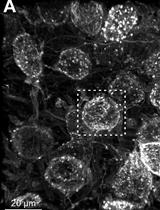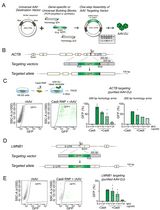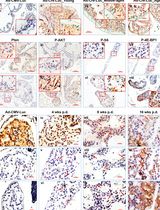- EN - English
- CN - 中文
A Novel Dual Lentiviral CRISPR-based Transcriptional Activation System for Gene Expression Regulation in Neurons
一种新型基于CAS9双载体慢病毒转录激活系统的神经组织基因表达调控
发布: 2019年09月05日第9卷第17期 DOI: 10.21769/BioProtoc.3348 浏览次数: 7247
评审: Alessandro DidonnaPamela MaherMarzia Di Donato
Abstract
Robust and efficient gene expression control enables the study of a gene’s function in the central nervous system. Advances in CRISPR-based technology provide new avenues not only for gene editing, but for complex transcriptional control. Here, we describe a protocol to generate high-titer lentiviruses with neuron-optimized CRISPR-activation constructs (dual lentiviruses consisting of a gene-specific single guide RNA and the CRISPR-activator) for use in primary neurons in vitro or in the adult brain in vivo. This protocol enables modular, scalable, and multiplexable gene regulation in the nervous system and does not require a transgenic model organism.
Keywords: CRISPR-Cas9 (CRISPR-Cas9)Background
The study of gene expression in the central nervous system is challenging due to difficulties in transgene delivery in post-mitotic neurons. Approaches to induce gene expression have typically relied on the use of transgenic animal models (Ericsson et al., 2013) and viral overexpression vectors (Prelich, 2012). These techniques are resource and time-consuming to make, neglect the endogenous gene locus, are limited by viral cargo capacities, and generally only target one gene at a time. CRISPR-Cas9 gene editing technology has been adapted to recruit effector proteins, such as transcriptional activators, to enable precise control over transcription (Chavez et al., 2015; Savell and Day, 2017). We recently optimized a CRISPR-activation (CRISPRa) system for robust, specific, titratable, and multiplexable gene induction in neurons both in vitro and in vivo by adapting available CRISPRa tools to be expressed with a dual lentivirus approach (Savell et al., 2019). This dual lentivirus system is composed of lentiviruses containing a gene-specific single guide RNA (sgRNA) and the dCas9-VPR (a strong transcriptional activator). Multiplexing at a single gene involves recruiting multiple dCas9-VPR effectors to a single gene’s promoter to boost transcription of that gene by pooling sgRNAs targeting the same gene. Multiplexing multiple genes is possible through combining sgRNAs targeting each of the desired genes.
This protocol is divided into subsections to outline 1) identification of sgRNA targeting sequences for CRISPRa and cloning the targeting sequence into the sgRNA scaffold, 2) maintaining and using HEK293T cells for lentivirus production, 3-4) lentivirus preparations on different scales for use in vitro and in vivo, 5) transduction guidelines for in vitro applications, 6) Transduction of adult neurons in vivo.
Part I: Identification of sgRNA targeting sequence for CRISPRa at gene promoters and cloning the target sequence into the sgRNA scaffold
Materials and Reagents
- Pipettes (Rainin, catalog number: 17014415 & 17014393)
- 1-2 L vented baffled flask (Fisher Scientific, catalog numbers: 50-121-4761 & 50-153-2267)
- Pipette tips (Denville, catalog numbers: 1159M43, 1159M40, 1159M42; Rainin, catalog number: 30389274)
- Corning Falcon round-bottom polystyrene tubes (Fisher, catalog number: 14-959-7)
- Nalgene General Long Term Storage Cryogenic Tube, sterile, 1.5 ml (Fisher, catalog number: 03-337-7Y)
- Custom oligos with correct overhangs (outlined in Part II), standard desalted purification
U6 validation primer: TTTCTTGGGTAGTTTGCAGTTTT - T4 polynucleotide kinase (PNK) (NEB, catalog number: M0201S)
- One Shot Stbl3 Chemically Competent E. coli (Invitrogen, catalog number: C737303)
- DNA ligase (NEB, catalog number: M0202S)
- Lenti U6-sgRNA/EF1a-mCherry (Addgene, catalog number:114199)
- NEBuffer 2 (NEB, catalog number: B7002S)
- FastDigest BpiI (Bbsi) (Thermo Fisher, catalog number: FD1014)
- Alkaline Phosphatase, Calf Intestinal (CIP) (NEB, catalog number: M0290S)
- Autoclaved MilliQ H2O
- PCR Purification Kit (Qiagen, catalog number: 28106)
- T4 ligation reaction buffer (NEB, catalog number: B0202S)
- imMedia Growth Medium, agar, ampicillin (Invitrogen, catalog number: 450034)
Note: Follow manufacturer’s instructions for preparation of the plates. - S.O.C. Medium (Invitrogen, catalog number: 15544034)
- Ampicillin sodium salt (Gibco, catalog number: 11593-027)
Note: Resuspend in sterile H2O, store aliquots at -20 °C. - Qiaprep Spin Miniprep Kit (Qiagen, catalog number: 27106)
- OneTaq 2x master mix with standard buffer (NEB, catalog number: M0482S)
- PureLink HiPure Plasmid Filter Midiprep Kit (Fisher, catalog number: K210015)
- PureLink HiPure Plasmid Filter Maxiprep Kit (Fisher, catalog number: K210017)
- TE buffer
- 2XYT broth with ampicillin (see Recipes)
- Tryptone (Fisher, catalog number: BP1421-500)
- Yeast extract (Fisher, catalog number: BP1422-500)
- Sodium chloride (Fisher, catalog number: S271-1)
Equipment
- -80 °C freezer (Thermo Fisher Scientific, model: UXF60086A63)
- Thermal cycler (Bio-Rad, C1000 Touch Thermal Cycler)
- Heat block (Fisher Scientific, Mini Heat Block 14955218)
- Large incubating orbital shaker set to 37 °C and 225 rpm (New Brunswick, G-25 Controlled Environment Incubator Shaker)
- Small shaker/incubator set to 37 °C (Fisher Scientific, Mini-Shaker 02217753)
- Tabletop centrifuge (Eppendorf, model: 5340)
- Refrigerating centrifuge that can accommodate up to 50ml conical tubes and a speed up to 12,000 x g (Eppendorf, model: 5810R)
- Gel electrophoresis equipment (Bio-Rad, Min-Sub Cell GT Cell)
Procedure
文章信息
版权信息
© 2019 The Authors; exclusive licensee Bio-protocol LLC.
如何引用
Readers should cite both the Bio-protocol article and the original research article where this protocol was used:
- Savell, K. E., Sultan, F. A. and Day, J. J. (2019). A Novel Dual Lentiviral CRISPR-based Transcriptional Activation System for Gene Expression Regulation in Neurons. Bio-protocol 9(17): e3348. DOI: 10.21769/BioProtoc.3348.
- Savell, K. E., Bach, S. V., Zipperly, M. E., Revanna, J. S., Goska, N. A., Tuscher, J. J., Duke, C. G., Sultan, F. A., Burke, J. N., Williams, D., Ianov, L. and Day, J. J. (2019). A neuron-optimized CRISPR/dCas9 activation system for robust and specific gene regulation. eNeuro 6(1). doi: 10.1523/ENEURO.0495-18.2019.
分类
神经科学 > 细胞机理 > 组织分离与培养
分子生物学 > DNA > 基因表达
您对这篇实验方法有问题吗?
在此处发布您的问题,我们将邀请本文作者来回答。同时,我们会将您的问题发布到Bio-protocol Exchange,以便寻求社区成员的帮助。
Share
Bluesky
X
Copy link













